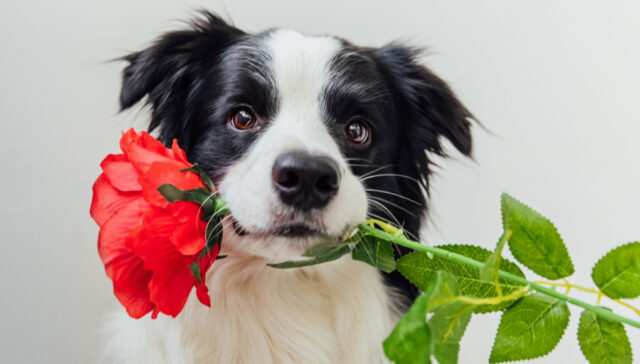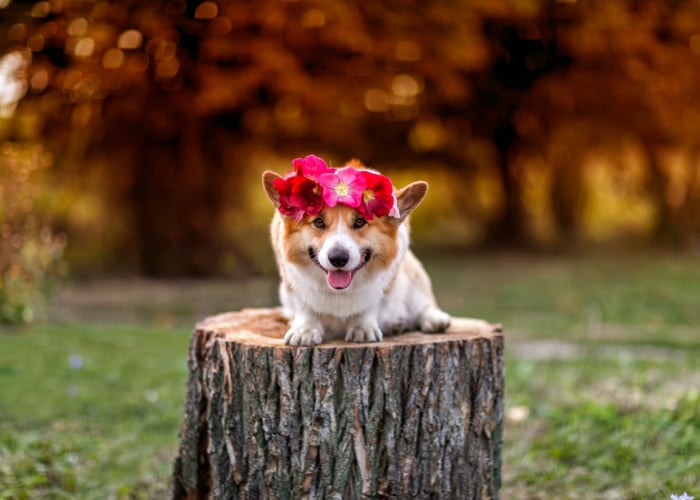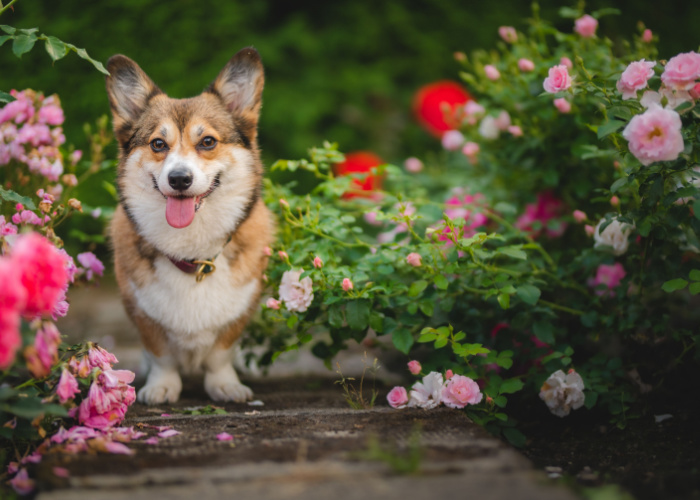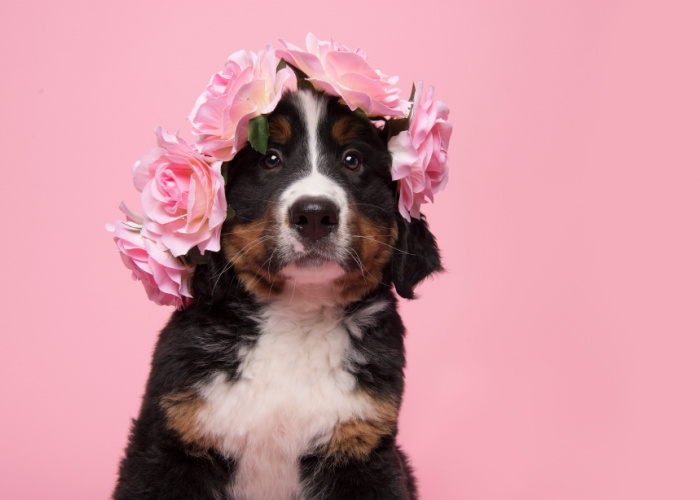
Table of Contents
- Are Roses Toxic to Dogs?
- Beware: Toxic Plants With ‘Rose’ Names That Don’t Actually Belong to the Rose Family
- 15 Pet-Friendly Rose Species
- Pup-Friendly Rosaceae Plants
- Not-So-Friendly Rosaceae Fruit-Bearing Trees
- Potential Risks of Roses to Dogs
- Are Roses Toxic to Dogs: FAQs
- Are Roses Toxic to Dogs: Before You Go…
If you’re a pup lover and a plant aficionado at the same time…
Then, choosing among hundreds of flowers to grace your garden can be quite a challenge.
And chances are, you might bump into this go-to Valentine's present that plant breeder David Austin is famous for — roses!
Uh, well, I have a heavy chewer pup at home, too.
Luckily, you found the right article to help you answer that question.
Are roses toxic to dogs?
Well, according to Dr. Joanna Woodnutt, roses are “predominantly non-toxic to dogs.”
A study also shows that “dogs interacted more frequently” with the rose scent.
Not only are roses safe, but our canine companions also adore their smell.
The same study suggests that taking your pup's smell preferences into account could be:
…an important element of enriching and improving the environment shared by [the] dogs with humans
What a relief, isn’t it?
But don’t let your guard down just yet.
That’s because there are underlying harm that dogs eating roses can suffer from. (Important!)
Not to mention the seemingly unnoticeable threat of rose impostors everywhere.
So, for the love of dogs and roses, let’s start and go for a deeper dive!

Are Roses Toxic to Dogs?
Roses are not considered to be toxic to dogs and other pets.
But remember, these plants come with thorns or prickles that are potentially harmful to your dog’s health when in close contact or ingested.
It’s also vital to note that too much ingestion of the rose plant can cause digestive upsets in your dogs.
So, pay attention to your pups while dealing with rose plants indoors or outdoors.
Beware: Toxic Plants With ‘Rose’ Names That Don’t Actually Belong to the Rose Family
When choosing or buying a rose plant, ask your florist for its botanical (or genus) name Rosa to ensure it's a true rose variety.
Remember, some plants bear the ‘Rose’ name but aren’t really classified as a Rosaceae family.
Note: In unfortunate cases of dog poisoning, call your vet or the Pet Poison Helpline (855-764-7661) immediately.
So, if you want to add a flower that symbolizes love to your landscape, consider avoiding the following false ones:
1. Moss Rose
Family: Portulacaceae
With its striking and vivid colors of pink, yellow, purple, white, red, and orange, you can guess the Moss Rose plant is harmless.
But beware, just because it bears the name ‘Rose’ doesn’t mean it’s dog-safe.
That’s because Moss Roses contain a toxic property called soluble calcium oxalates.
And because it’s soluble, this toxin can enter your dog’s bloodstream, making it more dangerous when left untreated or unnoticed.
When ingested, your dogs can experience the following Moss Rose poisoning symptoms, especially in large amounts:
- Diarrhea
- Drooling
- Vomiting
- Seizures
- Weakness
- Kidney failure
- Heart palpitations
- Muscle spasms or tremors
- Abdominal pain and swelling
Be extra careful as this plant also goes by different names, such as:
- Pusley
- Sunplant
- Pigweed
- Sun rose
- Purslane
- 9 o’clock
- 11 o’clock
- Rock rose
- Time flower
- Rock moss
- Rose moss
- Mexican rose
- Wild portulaca
- Afternoon flower
- Moss-rose purslane
2. Rose of Sharon
Family: Malvaceae
Despite being a Hibiscus type which is known as dog-safe, the Rose of Sharon plant is hazardous to your pup, even in horses.
This trumpet-shaped flower’s toxic property remains unknown.
But your dogs can be attracted to feasting on it due to its pleasant smell.
When ingested, your Fidos can suffer from mild to severe poisoning depending on the amount eaten.
If you suspect Rose of Sharon poisoning in your pups, take note of the following symptoms:
Pay attention; this flowering shrub is commonly known by the following names:
- Rose mallow
- Rose of China
- St. Joseph’s rod
3. Primrose
Family: Primulaceae
Typically the first to bloom in spring, the Primrose is another elegant plant that can totally beautify your garden.
Only that this nature’s beauty isn’t dog-friendly.
If any part of the Primrose plant is ingested, your furballs can suffer from digestive issues when eaten in large quantities.
Although the toxin is unknown and death is unlikely, prevention is the best form of cure and means to keep your pups safe.
If you found your pups feasting on your Primrose garden, watch out for the following symptoms of poisoning:
4. Rosebay
Family: Ericaceae
Known as a Rhododendron variety, the Rosebay plant definitely carries a huge red flag to your pups.
What’s the alarm all about?
Rosebay plants contain a strong toxin called grayanotoxins.
This neurotoxin can harm your pets even in just a small amount.
In cases of Rosebay ingestion, you can notice the following effects in your Fido’s body:
- Tremors
- Vomiting
- Diarrhea
- Seizures
- Weakness
- Abdominal pain
- Loss of appetite
- Excessive drooling
- Abnormal heart rate
- Low blood pressure
- Rapid, shallow breathing
You might be familiar with the following names; get rid of them immediately:
- Azalea
- Great Laurel
- Rhododendron
- Great Rhododendron
- American rhododendron
5. Christmas Rose
Family: Ranunculaceae
Typically blooming in winter, don’t forget to add the Christmas Rose to your dangerous plants for dogs list.
Despite its innocent name, this seasonal houseplant contains not just 1 toxin but 3:
- Saponosides
- Protoanemonin
- Glycosides (hellebrin, helleborin, and helleborein)
Glycosides or cardiotoxins can also tighten the heart muscles and affect the kidneys.
From its beautiful flowers down to the roots, the Christmas Rose can cause poisoning in your furballs characterized by the following symptoms:
- Lethargy
- Vomiting
- Drooling
- Excessive thirst
- Pain in the abdomen
- Upset stomach or diarrhea
Be careful; you might come across a Christmas Rose plant with the following names:
- Hellebore
- Easter Rose
- Lenten Rose
6. Desert Rose
Family: Apocynaceae
You may be fooled by its name.
But think twice; the Desert Rose isn’t a relative of the Rosaceae family.
Not even close!
This succulent plant may be attractive with its white and pink flowers.
But when your dogs lick the sap or munch on any parts of the plant, they’ll experience mild to severe poisoning.
Depending on the severity of the poisoning, signs of toxicity can include:
- Anorexia
- Vomiting
- Diarrhea
- Depression
- Irregular heartbeat
Like the Christmas Rose, this succulent plant contains the toxin cardiac glycosides.
It may be often administered to dogs with heart disease, but never for a healthy pup.
Warning: Cardiac glycosides can alter your healthy dog’s electrolyte balance of the heart muscle.
Again, some plants have a lot of nicknames. So, watch out for the following Desert Rose monikers:
- Sabi Star
- Kudu Lily
- Impala Lily
- Mock Azalea
- Desert Azalea

15 Pet-Friendly Rose Species
The rose plant of the Rosa genus (plant hierarchy below a family) consists of more or less 300 species around the world.
Fortunately, the rose plant is considered to be non-toxic to dogs and other pets.
So, this list will help you get a good glimpse of other rose species (below the genus rank) that are safe for your pooch at home:
1. Bonica
| Botanical Name | Rosa Bonica |
| Size Upon Maturity | 3 to 5 feet |
| Light Requirement | Full sun |
| Soil Quality Requirement | Rich, well-drained |
| Special Features | Fragrant light-pink flowers |
2. Easy Does It
| Botanical Name | Rosa Floribunda Easy Does It |
| Size Upon Maturity | 3 to 5 feet |
| Light Requirement | Full sun |
| Soil Quality Requirement | Rich, well-drained, humus |
| Special Features | Double, ruffled petals with a mildly fruity aroma and a mix of orange, pink, and apricot petal colors |
3. Cherry Parfait
| Botanical Name | Rosa Floribunda Cherry Parfait |
| Size Upon Maturity | 6 to 11 feet |
| Light Requirement | Full sun |
| Soil Quality Requirement | Well-drained, fertile |
| Special Features | Two-tone petal color pattern with white petals on red edges |
4. Rainbow Knockout
| Botanical Name | Rosa Rainbow Knockout |
| Size Upon Maturity | 3 to 4 feet |
| Light Requirement | Full sun |
| Soil Quality Requirement | Well-drained, fertile |
| Special Features | Classic single flowers with coral and a yellow center; have an excellent rebloom cycle or the process of flower blooming in the same season or time |
5. Julia Child
| Botanical Name | Rosa Floribunda Julia Child |
| Size Upon Maturity | 2 to 3 feet |
| Light Requirement | Full sun |
| Soil Quality Requirement | Well-drained, wide range |
| Special Features | Very shiny leaves and butter gold colored flowers with sweet licorice aroma; has great rebloom cycle |
6. Morden Fireglow
| Botanical Name | Rosa Floribunda Morden Fireglow |
| Size Upon Maturity | 2 to 4 feet |
| Light Requirement | Full sun |
| Soil Quality Requirement | Well-drained, fertile |
| Special Features | Mildly fragrant, double, cupped flowers with reddish to orange color |
7. Tahitian Sunset
| Botanical Name | Rosa Hybrid Tea Tahitian Sunset |
| Size Upon Maturity | 5 to 6 feet |
| Light Requirement | Full sun |
| Soil Quality Requirement | Well-drained, enriched |
| Special Features | Faint anise-smelling apricot-pink bi-color flowers |
8. Mardi Gras
| Botanical Name | Rosa Floribunda Mardi Gras |
| Size Upon Maturity | 3 to 4 feet |
| Light Requirement | Full sun |
| Soil Quality Requirement | Earthy, well-drained |
| Special Features | Peppery-fragrant flowers that initially bloom in an apricot-orange color and transform into bright pink and orange bloom with a yellow base as the petals spiral open |
9. Pat Austin
| Botanical Name | Rosa Pat Austin |
| Size Upon Maturity | 4 to 5 feet |
| Light Requirement | Full sun |
| Soil Quality Requirement | Wide range, enriched |
| Special Features | Tea-scented double-cupped flowers named after renowned rose plant breeder David Austin’s wife, Pat |
10. About Face
| Botanical Name | Rosa Grandiflora About Face |
| Size Upon Maturity | 5 to 6 feet |
| Light Requirement | Full sun |
| Soil Quality Requirement | Well-drained, enriched |
| Special Features | Fresh apple-scented bi-colored petals with a (slightly lighter hue) deep golden yellow with a darker bronzy orange-red backside |
11. Wild Blue Yonder
| Botanical Name | Rosa Grandiflora Wild Blue Yonder |
| Size Upon Maturity | 3 to 5 feet |
| Light Requirement | Full sun |
| Soil Quality Requirement | Well-drained, earthy |
| Special Features | Strong citrusy scented flowers with mauve and light purple petals |
12. Elle
| Botanical Name | Rosa Hybrid Tea Elle |
| Size Upon Maturity | 3 to 5 feet |
| Light Requirement | Full sun |
| Soil Quality Requirement | Sandy, enriched, well-drained |
| Special Features | Strong citrus and spice-scented flowers with a combo of regular and washed-out pink color |
13. Frankly Scarlet
| Botanical Name | Rosa Floribunda Frankly Scarlet |
| Size Upon Maturity | 2 to 3 feet |
| Light Requirement | Full sun |
| Soil Quality Requirement | Well-drained |
| Special Features | Consists of 20-25 strong scarlet red-colored petals with a spicy fragrance |
14. Teasing Georgia
| Botanical Name | Rosa Teasing Georgia |
| Size Upon Maturity | 4 to 5 feet or taller in warmer climates |
| Light Requirement | Full sun |
| Soil Quality Requirement | Well-drained, rich |
| Special Features | Strong-scented yellow to apricot-colored, small clusters of large cupped flowers |
15. Falstaff
| Botanical Name | Rosa Falstaff |
| Size Upon Maturity | 4 feet |
| Light Requirement | Full sun |
| Soil Quality Requirement | Well-drained, rich |
| Special Features | Consists of large, dark crimson-red flowers; regarded as David Austin’s best |
Pup-Friendly Rosaceae Plants
Rosaceae, or the rose family (plant ranking above genus), is home to various species, including herbs, vines, shrubs, and trees.
This family is usually characterized by leaves that are arranged alternately along the stem.
Some genera (genus) come with thorns or prickles, like the Rosa.
So, if you desire to grace your garden with this plant, here’s a list of the Rosaceae family that are dog-friendly:
- Cinquefoil
- Creeping Rubus
- Black Hawthorn
- English Hawthorn
- Haws or Haws Apple
- Salad Burnet
- Strawberry
- Weisdornbluten
Not-So-Friendly Rosaceae Fruit-Bearing Trees
Not all Rosaceae family plants are dog-safe.
Some fruit-bearing tree varieties cause more harm than good.
|
Rosaceae Family Plants |
Toxic Property |
Symptoms |
| Plum | Cyanogenic glycosides (cyanide) | Dilated pupils, difficulty breathing, panting, shock |
| Peach | ||
| Sweet Cherry |
Potential Risks of Roses to Dogs
Note: In unfortunate cases of dog poisoning, call your vet or the Pet Poison Helpline (855-764-7661) immediately.
Fertilizers and Other Rose Care Products
Sometimes, disulfoton is used in rose granule products or non-spray fertilizers, insecticides, and disease control.
When your pets come in contact with this chemical, it’s considered to be “deadly,” according to ASPCA.
And when ingested, your dogs can suffer from the following symptoms and side effects:
- Vomiting
- Diarrhea
- Urination
- Salivation
- Breathing difficulty
- Lacrimation or excessive release of tears
- Miosis or excessive tightening of the eye’s pupil
In severe cases, your dogs can vomit and pass stool with blood.
When your pup’s central nervous system is also affected, they’ll experience seizures and fall into a coma.
Thorns
The real obvious threat is the rose plant’s thorns.
Even when your dogs aren’t feasting on them, they’ll potentially get scratched when they’re playing outdoors.
Your dog might also step on dead rose plants, which the dried thorns can pose more danger.
Thus, be sure to clean the wound immediately to prevent further infections.

Are Roses Toxic to Dogs: FAQs
Are roses safe for dogs to smell?
Roses are safe for dogs to smell.
Most rose varieties have fragrant scents like citrus, faint anise, and sweet licorice that dogs may like.
Be careful, however, of the plant’s thorns which can potentially harm your pet.
Are rose petals toxic to dogs?
Rose petals aren’t toxic to dogs. They can eat it raw.
However, be sure that the rose plant is safe from insecticides and other chemicals.
When your dogs eat chemically-treated rose petals, they can suffer from mild to severe poisoning.
Are rose bushes toxic to dogs?
Rose bushes aren’t toxic to dogs, but it’s a potential choking hazard for your pet.
Not only are the stems fibrous and hard to chew, but it also contains thorns that can cause digestive blockages and irritation.
So, letting your dogs feed on rose bushes isn’t practical at all.
Are rose leaves toxic to dogs?
Rose leaves aren’t toxic to dogs, but this shouldn’t necessarily mean they can eat them all the time.
Potential hazards include rose plants that are chemically treated with insecticides, care products, and fertilizers.
When ingested, your dogs can suffer chemical poisoning leading to seizures and coma.
Are rose stems poisonous to dogs?
Rose stems aren’t poisonous to dogs but are a potential choking hazard.
The plant’s fibrous and thorny stems can cause intestinal blockages and throat irritation.
When ingested in large quantities, your dogs can also experience difficulty passing stool.
So, be on the safe side and avoid letting your dogs feast on rose stems.
Are Roses Toxic to Dogs: Before You Go…
When you’re a pup parent and a plant enthusiast at the same time, you can’t deny but ask yourself:
“Are roses toxic to dogs?”
However, the real question is whether dogs should eat roses or not, right?
So, regardless if roses are poisonous or safe for dogs, keeping this plant away from your Fido is practical.
Not only will you prevent them from potential harm, but you’ll also help them live quality lives by sticking to their vet-recommended diets.
Enjoyed this blog?
You might find the following recommendations helpful, too!













